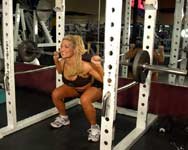The amazing counterpoint to such phenomena is that we seldom question our own reasoning. We all have habits, learned when we were just starting out. Simple things, like for instance, how we wrap our knees.
I have wrapped my knees the exact same way for the last 20+ years. I wrap in the manner where the wrap crosses diagonally across the kneecap, making what appear to be overlapping "X"s working up the knee. The rationale being that since a wrap is made to stretch lengthwise, more vertical wrap over the knee equals more stored energy and a bigger squat. This method seems to make sense and has worked for me over the years.
Nearly every other lifter I know wraps in a spiral, overlapping roughly parallel layers working up or down the knee with almost no wrap placed vertically over the knee. This method was obviously inferior (please note this is sarcasm) for two reasons.
First, wraps stretch lengthwise. If no wrap passes vertically over the knee it cannot stretch efficiently and therefore does not provide maximum rebound. Secondly, that's not the way I did it.
While we all accept some aspects of what we learned as fact, I have never seen any actual data to prove I was right and the other 90% of the world was wrong. So I decided to prove my theory myself in a logical fashion that other meatheads would understand.
It seemed reasonable that the amount of rebound provided by a wrap would be proportional to the stretch it experienced. The wraps stretch as the knee bends, descending from standing to below parallel in the squat. More stretch should translate to more rebound. Therefore, by measuring the stretch, we can measure the potential rebound provided by each method of wrapping.
The stretch could occur in one of two perpendicular directions, either along the length of the wraps or across its width.
To measure the changes in a wrap during a squat, my training partner and I drew a 1.5 inch square on an un-stretched wrap. The box was drawn with sides parallel and perpendicular to the edge of the wrap.
We wrapped a knee diagonally, and took pictures of the knee while standing erect, and again at parallel. The procedure was repeated with the knee wrapped spirally. We used a 14" box to ensure that the amount of knee bend was identical for both trials. By measuring the change in the 1.5 inch square, we reasoned that we could measure the change in stretch throughout the squat.
After the pictures were developed, measurements were made along the edges of the square. We recorded the starting length and the final length of the square in both directions. We used the date to calculate the percentage change, from the initial length. The greater the change in length, the more rebound the wrap should provide.
Yeah, yeah, I know this sounds like a lab report from high school, but if we didn't go through this everyone would figure the article was BS because the conclusions didn't agree with their opinion. Now you can all realize that I'm actually right.
The raw data, change in dimensions and change as a percentage of original length are provided in the following tables:
Table #1: Spiral Wrap
| Trial #1 | Length | Width |
| Standing | 19.3 | 13.9 |
| Parallel | 22.3 | 15.0 |
| Change in dimension (units) | 3.0 | 1.1 |
| Change in dimension (%) | 15.54% | 7.91% |
Table #2: Diagonal Wrap
| Trial #2 | Length | Width |
| Standing | 17.9 | 14.2 |
| Parallel | 21.4 | 14.8 |
| Change in dimension (units) | 3.5 | 0.6 |
| Change in dimension (%) | 19.55% | 4.23% |

To Summarize The Results

- Using the diagonal method caused the wrap to stretch more along it's length than the spiral method. The stretch increased by 26% with the diagonal wrap.
- Using the spiral method caused more stretch across the width of the wrap, than the diagonal method. The perpendicular stretch increased by 83% with the spiral method.
- The total stretch for length and width for both methods were identical.

Conclusion

The $1,000,000 question is "Which wrapping style will make me squat more?"
Interestingly, the total amount of stretch was identical in both methods. If elastic recoil is equal in both directions (we did not attempt to measure this) both methods would be pretty close. The only answer I can justify completely is "My way is, always has been and always will be the best."
 |
|||
 |
|
 |
|
 |
|||
That said, if you spiral wrap, take a good look at your knee wraps.
When you spiral wrap approximately 1/3 of the stretch occurs across the width of your wraps (twice as much as with the diagonal wrap). If your wrap is designed to stretch in only one direction, you lose 1/3 of the potential rebound. If we assume wraps give an additional 20 pounds, you just gave away 3 to 5 on your squat.
Five pounds won't turn most of us into 1,000 pound squatters, but it could change your placing in a close meet, or make a new PR. The bottom line is look at your equipment as objectively as possible. Smarter training is better training. Over a lifetime of lifting, an additional 5 pounds here and 3 pounds there add up.
Other Recommended Reading:










